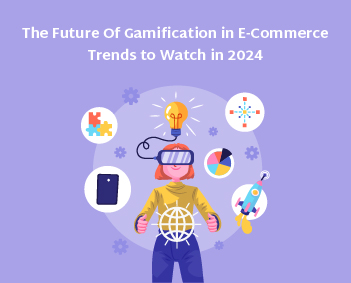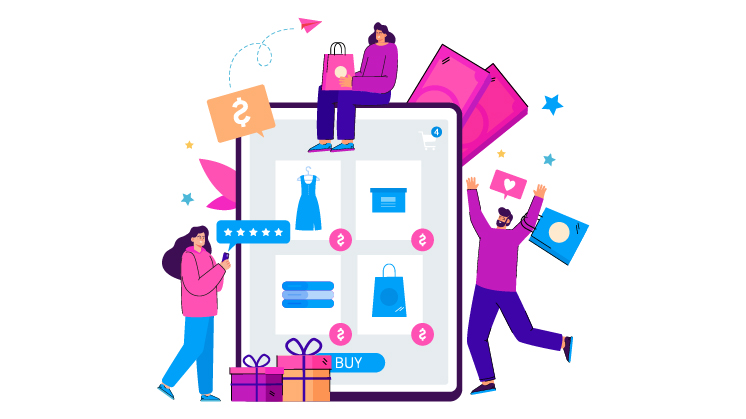Gamification in e-commerce allows online retailers to interact with their customers. Gamifying aspects of online buying will boost customer retention and exposure as companies look for new, entertaining, and dynamic ways to draw in new clients. The top 9 future trends of gamification in eCommerce discussed here will transform shopping in the near future.

In simple terms, gamification in e-commerce involves incorporating gaming features into retail settings. Several methods exist; some features will work better for your company than others. Leaderboards, scavenger hunts, loyalty point systems, quizzes, and “spin-the-wheel” are examples of gamification components. You may go one step further for firms with larger resources by using virtual reality to generate digital shop mock-ups. There are countless options.
You must maximize the customer’s experience because the average consumer has an attention span of eight seconds. Providing gamified experiences will encourage clients to make purchases from you. Ultimately, reaching objectives and “leveling up” are fulfilling experiences.
E-commerce gamification differentiates you from the competition. This is more crucial than ever in a market that is becoming increasingly competitive.
Gamification in Ecommerce – The Concept
It’s important to know what “gamification” is before examining future eCommerce gamification trends that will transform shopping.
Gamification in e-commerce is the process of bringing aspects frequently found in video games to the retail industry. However, gamification is a powerful tactic for consumers to interact with your brand. Key statistics are as follows:
- By 2025, gamification sales revenue alone will be worth $32B
- Businesses leveraging gamification techniques and strategies see a 7X higher conversion rate
- 70% of global 2000 companies leverage gamification techniques
Common Elements for Gamification in Ecommerce
Here are a few examples of gamification in eCommerce:
- Loyalty reward programs: As customers go through tiers, they accrue points and “level up.” By doing this, benefits like discounts become available. This promotes repeat business and client loyalty.
- Challenges: Make challenges with a time limit to get rewards. For instance, give clients a task to finish in a predetermined amount of time.
- Free shipping progress bars: Give clients a progress bar/indicator so they can see how close they are to “winning” free delivery. In the end, this will motivate customers to put more things in their carts.
- Tests and questionnaires: Use quizzes to provide clients with tailored product suggestions.
- Spin-to-win attributes: Customers can win free delivery or savings by playing interactive spin wheel games.
- Referral schemes: Give consumers who recommend friends points or prizes.
Key Trends to Watch in 2025 Regarding Gamification in Ecommerce
1. Personalized Rewards Systems
In 2025, personalization will be central to gamification strategies. E-commerce platforms are now crafting rewards systems tailored to each customer’s behavior, which increases the likelihood of repeat purchases. These systems offer points, badges, and level-ups based on customers’ browsing habits, past purchases, and engagement levels.
Benefits of Personalized Rewards for Ecommerce Gamification:
- Aligns with individual customer preferences, driving loyalty.
- Increases perceived value, as customers feel rewards are specially designed for them.
- Builds an emotional connection between the customer and the brand.
2. Social and Competitive Elements
Competition always gives powerful motivation, and 2025 is seeing a rise in competitive and social gamification in e-commerce. Many retail store owners are now allowing users to compare achievements, scores, or progress with others to encourage a sense of competition and win.
How Social Gamification Drives Engagement:
- Offers rankings and leaderboards to instill a competitive spirit.
- Integrate social sharing options to allow customers to flex their achievements.
- Inculcates brand loyalty via shared experiences.
3. Augmented Reality (AR) Games and Experiences
AR gamification combines digital and in-person shopping experiences that generate immersive buying environments. Through AR games, buyers can engage in virtual try-ons, treasure hunts, and product discovery games. All these gamification in ecommerce tactics can bridge the gap between online and in-store shopping.
Examples of AR Gamification:
- Virtual product hunts where customers “find” deals in an AR environment.
- AR filters that apply game effects to users’ photos, which they can share to earn rewards.
- Points or tokens are earned by interacting with 3D-rendered products.
4. Interactive Loyalty Reward Programs
Loyalty reward programs are more than just about points accumulation. Interactive gamified loyalty reward systems encourage buyers to actively participate in activities rather than passive collectors of reward points.
Innovative Loyalty Program Features:
- Daily Reward Challenges: Encourage customers for daily login rewards, special points, or exclusive discounts.
- Spin-to-Win Games: Allow users to play spin wheel games for free products or discounts.
- Levels and Tiers: Make customers unlock new rewards when they reach milestones in engagement or spending.
5. AI-Driven Adaptive Challenges
Artificial Intelligence (AI) is transforming gamification by creating adaptive challenges based on customer behavior. In 2025, AI-driven gamification enables businesses to offer dynamically adjusted experiences that keep users engaged without overwhelming them.
How AI Gamification Works:
- Monitors user behavior to adjust various challenges and ensures user engagement matches difficulty levels.
- Creates personalized game paths to guide customers to particular actions.
- Improves customer experience by ensuring gamification elements feel intuitive.
6. Team-based and Community Gamification
With a push toward community-driven e-commerce, gamification is becoming collaborative. In 2025, retail stores are offering team-based buying experiences where consumers can create groups, achieve tasks, and earn reward points as a team.
Community-oriented Gamification Strategies:
- Group Challenges: Encourages friends or fellow users to complete tasks together.
- Shared Reward Points: Enables teams to earn collective redeemable points for greater rewards.
- Referral Loyalty Programs: Gamified referrals that reward users for drawing in new customers and bolstering community growth.
7. Gamified Product Discovery
Gamified product discovery ensures customers engage in interactive experiences that showcase new products. This gamification in e-commerce trend is prominent in beauty, wellness, fashion, and technological e-commerce.
Types of Gamified Product Discovery:
Product Matching Quiz: Let customers reply to questions to “unlock” recommendations customized to their unique preferences.
Exploration Maps: Let buyers find a virtual catalog or store to discover hidden offers and deals.
Interactive Demos: Games such as ‘try-before-you-buy’ where users are able to test product features in a simulated environment.Turn every product demo, tutorial, or customer testimonial video into searchable blog posts, FAQs, or knowledge-base articles instantly with Video to Document Converter perfect for boosting SEO and repurposing video content at scale
8. Gamification in Ecommerce Through Mobile Apps
Mobile devices hold massive significance in e-commerce. In 2025, gamification in ecommerce via apps will continue to grow. Gamification through mobile apps encourages buyers to interact with a particular brand regularly via location-based loyalty rewards, exclusive app-only games, and more.
Effective Mobile Gamification Tactics:
- Location-specific reward points: Let customers earn reward points when visiting specific physical events or locations.
- Push Notifications: Gamification-led reminders encourage buyers to be involved and accomplish challenges.
- Exclusive In-App Rewards: Make App-specific loyalty rewards and offers unavailable on desktop versions.
9. Sustainable Shopping Rewards
Sustainability creates concern for everyone. Thus, gamified e-commerce platforms are striving to reward customers and entice them to make environment-friendly choices. This sustainability trend promotes ethical buying by incentivizing buyers to choose eco-friendly options.
Examples of Sustainable Gamification in Ecommerce:
- Eco-friendly Badges: Let buyers earn digital badges for purchasing recycled or eco-friendly products.
- Green Points: Earn gamification points that are redeemable or donatable towards environmental causes.
- Carbon Footprint Tracking: Shows the impact of purchases and rewarding users for low-impact choices.
Final Words
Gamification in e-commerce continues to reshape the online retail store world. Success in 2025 will depend on implementing the right mix of gamification elements while maintaining focus on user experience and measurable outcomes. Businesses must stay adaptable and responsive to changing consumer preferences while building sustainable, engaging gaming mechanics that drive real value.




